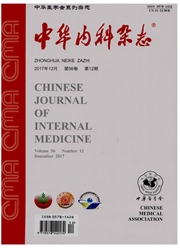

 中文摘要:
中文摘要:
目的探讨骨髓单个核细胞Coombs(BMMNC—Coombs)试验阳性血细胞减少(又称免疫相关性血细胞减少,IRP)患者骨髓巨噬细胞(Mm)活化抗原表达及其临床意义。方法采用流式细胞仪(FACS)检测61例IRP患者及10例重型再生障碍性贫血(SAA)(病例对照组)和13例正常人(正常对照组)骨髓造血细胞膜自身抗体类型、骨髓M①数量(CD未/CD未)%及Mm活化抗原(CD^69)表达水平(CD68^+CD69^+/CD68^+)%,并探讨其临床意义。结果61例IRP患者其Mm数量及活化抗原表达水平[(0.57±0.30)%和(40.30±18.49)%]均高于病例对照组[(0.46±0.08)%和(32.44±19.37)%]及正常对照组[(0.44±0.69)%和(29.71±11.67)%](P值均〈0.05);且其M中数量与活化抗原表达水平呈明显正相关(r=0.89,P〈0.01)。根据Mm数量分为A组(MФ百分率≥0.5%)和B组(Mm百分率〈0.5%),A组34例患者中32例(94.1%)有自身抗体IgG,B组27例患者中仅2例(7.4%);A组患者骨髓Mm活化抗原表达水平(49.19±16.63)%显著高于B组患者(29.H±14.30)%(P〈0.05),而B组患者和病例对照组及正常组无统计学意义(P值均〉0.05);A组患者的3、6个月的总有效率(分别为47.06%、79.41%)均明显优于B组患者同期的疗效(22.22%、51.85%)(P〈0.05);并且A、B组患者6个月的总有效率(79.41%、51.85%)均明显高于3个月的疗效(47.06%、22.22%)(P值均〈0.05)。34例自身抗体IgG(+)IRP患者按M中数量分为高(≥0.75%)、低(〈0.75%)水平2组,25例M中低水平组24例仅能检测到1系骨髓细胞(CD34^+或CD15^+或GlycoA^+)有自身抗体IgG(96%),1例检测到2系骨髓细胞有自身抗体IgG;9例Mm高水平组有8例能检测到2系骨髓细胞有自身抗体IgG,1例为3系骨髓细胞?
 英文摘要:
英文摘要:
Objective To explore the expression of antigen activated of macrophages (MФ) of bone marrow and its clinical significance in pancytopenia patients with positive bone marrow mononuclear cells (BMMNC)-Coombs test (immunorelated pancytopenia, IRP). Methods Sixty-one IRP patients, 10 severe aplastic anemia (SAA) patients and 13 healthy controls were enrolled in this study. The categories of auto-antibodies( lgG, IgM) on BMMNC( CD34^+/CD15^+/GlycoA^+ hematocytes), the quantity ( CD68^+/CD45^+) % and expression of antigen activated ( CD69 ) of MФ ( CD68^+ CD69^+/CD68^+ ) % in bone marrow of all cases and controls were measured by fluorescence activated cell sorting(FACS). Results The quantity and expression ratio of activated antigen of bone marrow ( BM ) MФ in IRP patients [ ( 0. 57 + 0. 30 ) % and ( 40. 30 ± 18.49)% ] were respectively significantly higher than those in SAA [ (0.46±0. 08)% and (32. 44 ± 19.37)%] and healthy controls [(0.44 ±0.69)% and (29.71 ±11.67)%] (both P 〈0.05). The quantity presented high-positive correlation with the expression ratio of activated antigen of BM MФ ( r = 0. 89, P 〈 0. 01 ). Patients with IRP were classified into two subgroups according to the quantity of MФ: Group A (MФ≥0. 5%, 34 cases) and Group B (MФ≤ 0. 5%, 27 cases). Thirty-two cases (94. 12% ) were with auto antibody (IgG) in Group A, while only 2 (7.41%) with auto antibody (IgG) in Group B. There was significant difference in expression ratio of activated antigen of BM MФ between Group A (49. 19 ± 16. 63 ) % and Group B ( 29. 11 ± 14. 30 ) % ( P 〈 0. 05 ), but no difference was found between Group B and the control group ( P 〉0. 05). Total curative rates at 3 and 6 month (47.06% and 79.41% ) of Group A were better than those of Group B (22.22% and 51.85% ). Thirty-four IRP patients with autoantibody (IgG) ( + ) were divided into two subgroups ac
 同期刊论文项目
同期刊论文项目
 同项目期刊论文
同项目期刊论文
 期刊信息
期刊信息
